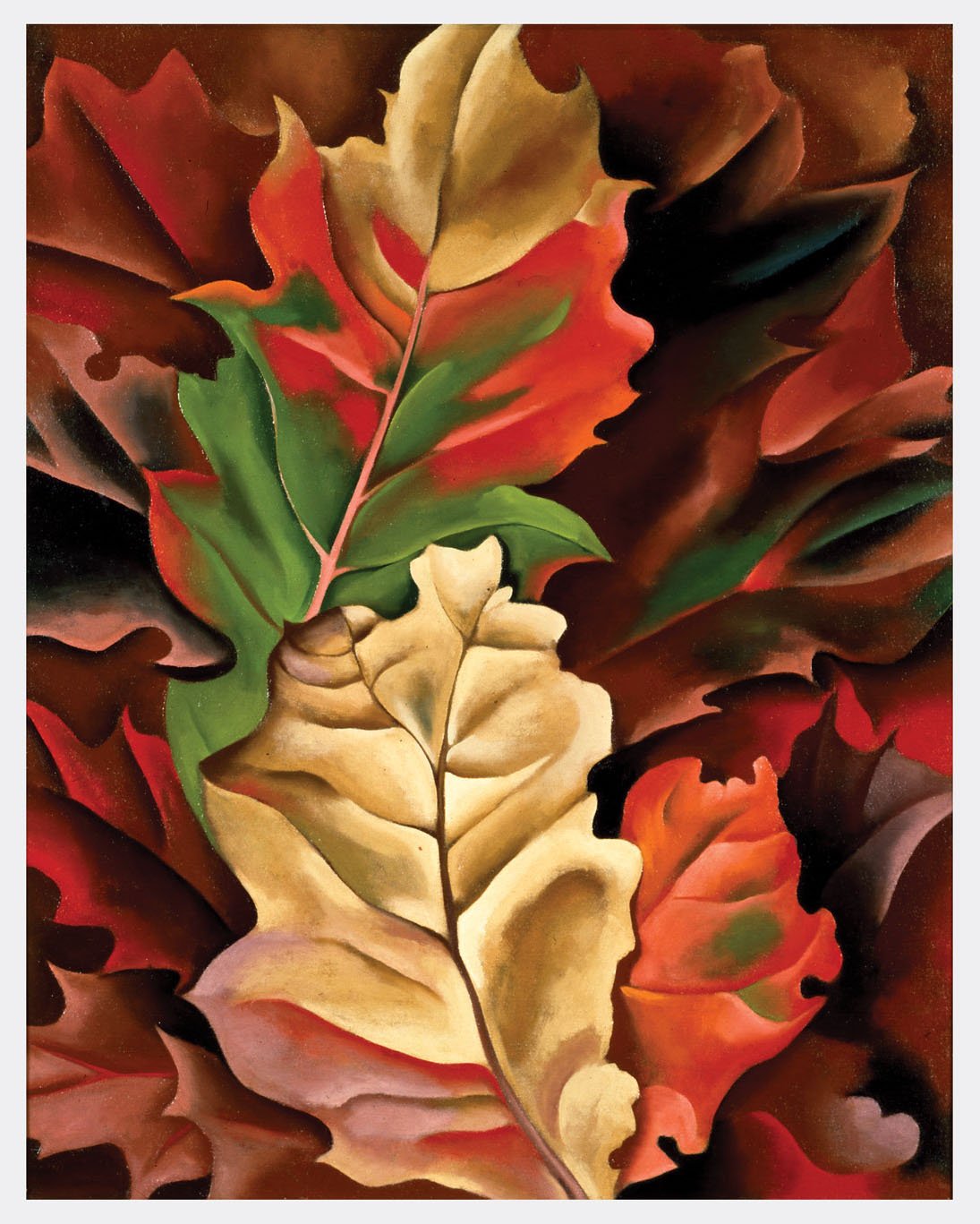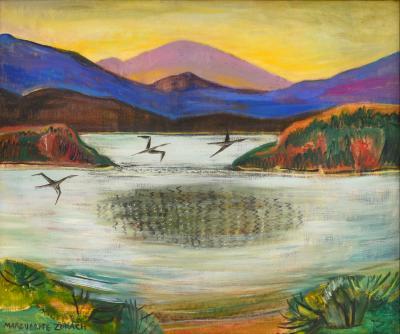Modern Nature: Georgia O'Keeffe and Lake George
From 1918 until 1934, Georgia O’Keeffe (1887–1986) lived for part of the year at Alfred Stieglitz’s (1864–1946) family estate in Lake George, located in New York’s Adirondack Park. The thirty-six-acre property was situated along the western shore, in the southern basin of the thirty-mile-long glacial lake popularly known as “the Queen of American lakes.” O’Keeffe typically stayed at Lake George from spring to fall and reveled in the discovery of new subject matter while finding respite in the bucolic setting of the Stieglitz property, a former farm. She enjoyed long walks through the wooded hillsides and hikes up Prospect Mountain to take in the spectacular view of the lake’s mountain-rimmed waters. In her humble studio, nicknamed the “shanty,” O’Keeffe found a place to concentrate on her work without the distractions of city life and the intrusions of the gregarious Stieglitz family who congregated at the lake house in the summer months. In 1923, she enthusiastically wrote to her friend, the writer Sherwood Anderson, “I wish you could see the place here—there is something so perfect about the mountains and the lake and the trees—Sometimes I want to tear it all to pieces—it seems so perfect—but it is really lovely—And when the household is in good running order—and I feel free to work it is very nice.”
 |
| Georgia O’Keeffe (1887–1986), Lake George, 1922. Oil on canvas, 16-1/4 x 22 inches. San Francisco Museum of Modern Art, San Francisco, California. Gift of Charlotte Mack. © Georgia O’Keeffe Museum/Artists Rights Society (ARS), New York. |
The majority of Georgia O’Keeffe’s Lake George landscapes follow a similar compositional format of mountains stretching across the upper third of the picture, a long band of water at the center, and a stand of trees in the foreground. In this painting of the lake at dusk, however, O’Keeffe departs from the more familiar landscape composition by removing the shoreline, eliminating all extraneous details, and distilling the mountain and lake scenery to its most elemental forms. The artist pushed the boundaries between the descriptive and the abstract a step further by fusing the mountain and its mirrored image on the surface of the water as one unified abstract design. The image has a dual orientation and can be read horizontally, as a more conventional landscape or, if the canvas were turned on its side, the abstract forms would dominate.
 |
 | Among the early subjects Georgia O’Keeffe explored while at Lake George were the apples that grew in an orchard on the Stieglitz farm. In 1920, there was an unusually successful apple harvest and, according to Alfred Stieglitz, she caught a case of “apple fever.” Not only did she concentrate on them as a subject, producing around twenty-five small, jewel-like compositions, O’Keeffe pressed the apples to make cider and sauce, and preserved them through canning. Apple Family–2 is characteristic of her still-life format, with its compressed, shallow space and vibrant coloration. The small scale of her apple paintings intensifies the sense of the fruit’s ripeness, while the tightly focused view and cropped composition evokes affinities with contemporary photography. Other references abound, including apples as a long-standing subject for American artists, symbolizing America’s wealth and abundance, and the preferred still-life subject of modern masters Gustave Courbet and Paul Cezánne. As its title suggests, O’Keeffe’s apple still lifes alluded to members of the Stieglitz family who summered at Lake George. | |
| Georgia O’Keeffe (1887–1986), The Chestnut Grey, 1924. Oil on canvas, 36 x 30-1/8 inches. Curtis Galleries, Minneapolis, Minnesota. © Georgia O’Keeffe Museum/Artists Rights Society (ARS), New York. |
 |
| Georgia O’Keeffe (1887–1986), From the Lake, No. 3, 1924. Oil on canvas, 36 x 30 inches. Philadelphia Museum of Art, Philadelphia, Pennsylvania. Bequest of Georgia O’Keeffe for the Alfred Stieglitz Collection (1987). © Georgia O’Keeffe Museum/Artists Rights Society (ARS), New York. |
O’Keeffe was surrounded by trees at Lake George, from the magnificent maples to the stately chestnuts, the elegant poplars, and the white birches, and transformed them into the subject of twenty-five canvases. In 1927, she told Frances O’Brien, “If only people were like trees . . . I might like them better.” Several of the trees she focused on were landmarks on the Stieglitz property, including the old chestnut, the subject of her earliest “big tree” paintings. Blighted by age and dying when O’Keeffe painted two nearly identical versions of it in the fall of 1924, the trunk of the chestnut tree is pressed close to the picture plane and the branches are severely cropped, emphasizing the cruciform shape of the noble tree, its strength, and endurance. Yet, its dark silhouette boldly outlined against the setting sun at dusk evokes a more elegiac mood.
| This is one of a series of three oil paintings O’Keeffe created in 1924 that are based on the sensation of looking down on the watery surface of Lake George. The artist’s intense observation of the reflective properties of the water resulted in a vibrant and visually disorientating pattern of abstracted flame-shaped forms that reflect the colors of the surrounding landscape. For example, the light refracted in the ripples of water reveals the glistening reflections of the verdant tones of the green trees and brown land that encircled the lake. O’Keeffe’s deep engagement with, and response to, the landscape of Lake George is revealed in her careful scrutiny of the beauty and bounty of the lake, and of her study of every facet of its natural phenomena, including the water’s surface. Through such practices, O’Keeffe exploited the tension between the representational and the abstract, resulting in some of her most innovative work. |  | |
| Georgia O’Keeffe (1887–1986), Autumn Leaves, Lake George, 1924. Oil on canvas, 20-1/4 x 16-3/8 inches, Columbus Museum of Art, Columbus, Ohio. Museum Purchase, Howald Fund II (1981.006). © Georgia O’Keeffe Museum/Artists Rights Society (ARS), New York. |
 |
| Georgia O’Keeffe (1887–1986), Petunias, 1925. Oil on board, 18 x 30 inches, Fine Arts Museums of San Francisco, de Young Museum, San Francisco, California. Museum purchase, gift of the M. H. de Young Family (1990.55). © Georgia O’Keeffe Museum/Artists Rights Society (ARS), New York. |
O’Keeffe collected organic souvenirs, from stones and shells to feathers and bones, and at Lake George she delighted in gathering leaves that appealed to her for the striking diversity of their shape and coloring. The majority of her leaf paintings exhibit a palette of browns, earthy reds, and shades of green, suggestive of autumn foliage, and, though enlarged and pressed close to and parallel with the picture plane, the leaves often retain their distinctive and identifiable shape. Autumn Leaves, Lake George, presents a bed of overlapping oak leaves whose forms are isolated and details magnified, drawing attention to the patches of summer’s green that cling to the fiery reds and golden hues of fall, O’Keeffe’s favorite season in the Adirondacks. She created twenty-nine leaf pictures between 1922 and 1931, all based on the leaves she collected at Lake George.
 |
| Georgia O’Keeffe (1887–1986), Lake George Barns, 1926. Oil on canvas, 21-3⁄16 x 32-1⁄16 inches, Collection Walker Art Center, Minneapolis, Minnesota. Gift of the T. B. Walker Foundation (1954). © Georgia O’Keeffe Museum/Artists Rights Society (ARS), New York. |
O’Keeffe not only used her natural surroundings at Lake George as a source of inspiration, she also mined the garden she maintained on the Stieglitz farm for fresh motifs and themes. In the summer of 1924, she began planting beds of blue and purple petunias in order to study their subtle, radiant hues. The growing of petunias that pivotal summer provided the impetus for her first enlarged floral painting, Petunia No. 2 (Georgia O’Keeffe Museum), an extraordinary prelude to the artist’s flower paintings, long considered her most original contribution to twentieth-century art. O’Keeffe’s preoccupation with petunias culminated in this 1925 canvas.
 |
| Georgia O’Keeffe (1887–1986), Starlight Night, Lake George, 1922. Oil on canvas, 16 x 24 inches. Private collection. © Georgia O’Keeffe Museum/Artists Rights Society (ARS), New York. |
Like many artists of her generation and earlier ones as well, O’Keeffe painted throughout the summer and fall and transported canvases back to her New York studio for completion and exhibition in the early spring. During this highly productive period, she created more than two hundred paintings on canvas and paper in addition to sketches and pastels, making her Lake George years among the most prolific and transformative of her seven-decade career.
While the paintings that resulted from this period have been included in numerous exhibitions and have been the subject of many articles and essays, never before have they been so intimately connected to the natural environment that inspired their creation. Modern Nature: Georgia O’Keeffe and Lake George was the first exhibition to illuminate the formative influence that this place had on the artist’s work. The exhibition provided an opportunity to explore the ways Lake George served as a rural retreat for the artist, providing the basic material for her art, while evoking the spirit of place that was essential to her modern approach to the natural world.
This period also coincided with O’Keeffe’s first critical success and professionalization as an artist; yet, Lake George is often portrayed as a place of unhappiness and frustration for the artist and one she continually tried to escape. This is attributed to the intrusive Stieglitz family and O’Keeffe’s intense need for privacy, as well as her dissatisfaction with the mountain scenery of the Adirondacks, causing her to yearn for the open spaces of the Southwest. Modern Nature departed from this commentary, focusing instead on how O’Keeffe’s connection to nature, which many consider fundamental to her art, deepened and intensified at Lake George, resulting in some of her most innovative work.
At the time this article was published, Erin B. Coe was chief curator at the Hyde Collection, Glens Falls, New York. She organized the exhibition, Modern Nature: Georgia O’Keeffe and Lake George in association with the Georgia O'Keeffe Museum. It traveled to various museums in 2013 and 2014.
This article was originally published in the Spring 2013 issue of Antiques & Fine Art magazine, now Incollect Magazine.































